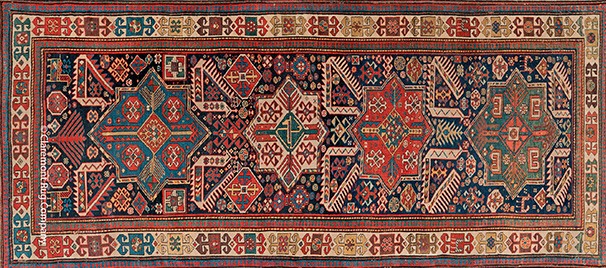Jan David Winitz Examines Antique Rugs from the Caucasus Mountains

 |
|
Akstafa, Southeast Caucasian, 4' 2" x 9' 2" — 3rd Quarter, 19th Century. |
Oakland, Ca - Last month, Art Daily and Jan David Winitz, founder/president of Claremont Rug Company, began a series of first person narratives and interviews that will discuss a wide range of topics related to the selecting, evaluating and collecting of antique Oriental rugs from the Second Golden Age of Persian Weaving, ca. 1800 to ca. 1910.
In this installment, I will provide personal reminiscences and insights into the culturally rich world of Caucasian rugs, produced by 85 distinct weaving groups in an area that is characterized by tribespeople who spoke over 100 languages. I’ll look closely at the history and traditions of the society that produced the weavers and other crafts people who created these timeless works of art.
Having bought my first Oriental rug while still a teenager and starting my company more than four decades ago at age 25, I have studied antique rugs as a collector, an art dealer and a lover of beauty. Over the years, Caucasian rugs have come to take a central place in my heart and my mind. Many of the first 40 rugs in our collection were Caucasian pieces. And they continue to comprise a central component of our trove.
I feel that I am in a unique position to do this, as over the past 40-odd years I’ve been privileged to have many conversations with elderly tribespeople who were the descendants of the weavers. I feel comfortable to present the interpretations that were shared by several of these people and concur with my own knowledge of the worldview of the tribes of the Caucasus and Persia.
I, as do many of our clients, have a longtime love affair with 19th century Caucasian rugs extending to superb folkloric pieces from other tribal groups: the finely woven Qashqais and the charming Afshar rugs of South Persia, as well as the spirited Kurdish rugs of Northwest Persian Azerbaijan. The finest 1800s pieces from these illustrious weaving traditions reveal an original character that celebrate the rhythms, colors and energy of the natural environment in which the weavers lived.
As I continued to explore symbolism in antique Caucasian rugs, I began to comprehend the relationship that the various tribal groups throughout the Near East had with animals and birds. Significant on many levels, animals not only provided sustenance and labor, but also the raw materials for the rugs they wove. The tribespeople also observed that animals possess various attributes that they strove to attain themselves. A lion possesses strength, a gazelle swiftness and gracefulness, and a bird freedom from constraints.
The tribespeople developed a distinct pragmatism, as they had to cope with dramatic changes in weather and the difficult terrain of the rugged Caucasus Mountains with sometimes meager resources at hand. In doing so, they depicted a myriad of animals and fowl in antique tribal rugs, including camels, sheep and birds of their daily life.
Sheep were a vital source of warmth and comfort, as well as the primary source of wool used for rug-weaving, which in itself was considered a sacred activity. The role of the ram's horn was as an instrument to summon people together crosses many cultures. It also acted as a symbol that life is self-perpetuating, and in this way has an eternal as well as temporary aspect.
They saw in the gazelle an innate ability to seemingly effortlessly navigate a rugged terrain. In this way, it symbolizes the virtues of strength and dexterity in overcoming the many harsh environments that life presents. It possessed for them the virtues of grace and dignity, which could be manifested in all situations and in all aspects of life.
The tribespeople associated the peacock with nobility and abundance. Their colorful plumes represented a great beauty and splendor that is at once earthly and heavenly. Both aspects were recognized: an external wealth from the divine and an inner richness that could be cultivated within oneself.
Though rug symbology has long been a “taboo” subject in some circles, because of the acknowledged difficulty in corroborating specific ancient meaning through the mists of time, it seems safe to conclude that tribal carpets were not produced entirely ex nihilo. Rather, they reflect the worldview of the peoples that produced them.
As the eminent scholar James D. Burns observed in his The Caucasus: Traditions in Weaving (1987), “because rugs were virtually the only art form they created, they naturally concentrated cultural and religious significance. In their striking geometries, there is an interplay between design and color that offers profound visual commentary on an underlying balance and harmony that the tribespeople felt to exist in all of nature and in the cosmos.”
In the next installment, which will be published next week, I will examine the philosophical relationships and beliefs that Caucasian weavers brought to their craftsmanship.
|
